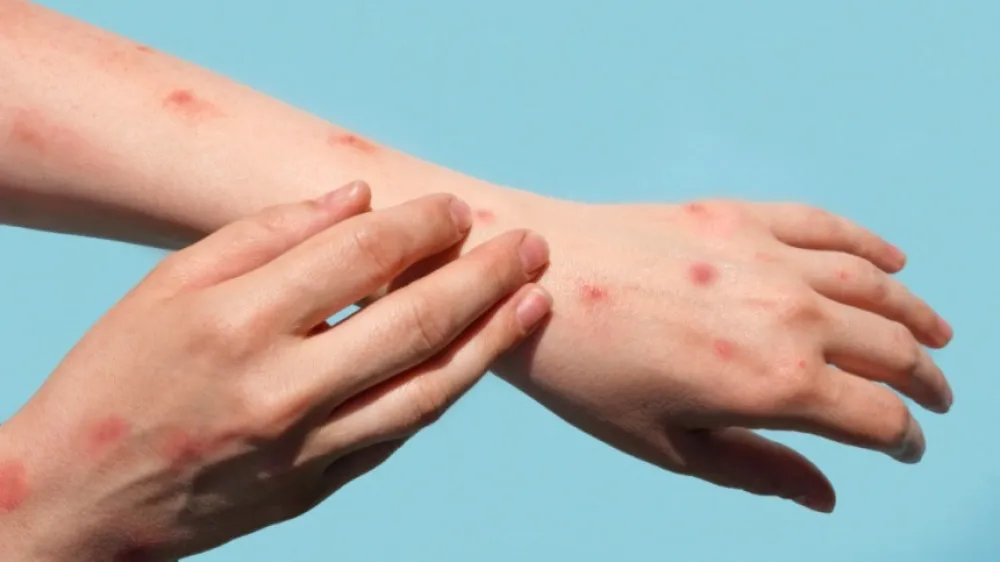Providing your location allows us to show you nearby locations and doctors.
Monkeypox: What you need to know

07/26/2022
Arm yourself with facts about monkeypox during the current outbreak in the United States
There is a current outbreak of monkeypox in the United States. While monkeypox is rare and often a mild illness, it is important to know what it is and how to avoid contracting the contagious virus.
Here is what you need to know about monkeypox.
What is monkeypox?
Monkeypox is a rare disease caused by infection with the monkeypox virus. Monkeypox virus is part of the same family of viruses as smallpox. Monkeypox symptoms are similar to smallpox symptoms but milder and rarely fatal. Different viruses cause monkeypox and chickenpox and they are not related.
How does monkeypox spread?
During this current outbreak, people with monkeypox reported they had close, sustained physical contact with other people who have monkeypox.
Monkeypox can spread through close, often skin-to-skin contact, including:
- Direct contact with monkeypox rash, scabs or body fluids from a person with monkeypox.
- Touching objects, fabrics such as clothing, bedding or towels, and surfaces that someone with monkeypox used and did not disinfect.
- Contact with respiratory secretions from someone with monkeypox talking, singing, coughing or sneezing.
Monkeypox can spread from the time symptoms start until the rash has fully healed and a fresh layer of skin has formed. People who do not have monkeypox symptoms cannot spread the virus to others.
What are monkeypox symptoms?
Symptoms of monkeypox usually start within three weeks of exposure. Some people may get a rash first and then other symptoms. Others may only get a rash with no other symptoms. The rash can be limited to one area of the body.
Monkeypox symptoms can include:
- A rash that can look like pimples or blisters and appear on the face, inside the mouth, and on other parts of the body, like the hands, feet, chest, genitals or anus.
- Fever
- Headache
- Muscle aches and backache
- Swollen lymph nodes
- Chills
- Exhaustion
What should I do after exposure to monkeypox?
If you have been exposed to monkeypox, monitor your symptoms for 21 days after the exposure. Monitor the following symptoms in particular:
- New skin rash
- Fever greater than 100.4°F (38°C)
- Chills
- Swollen lymph nodes in the neck, armpits or groin
If you have no symptoms, you can continue your daily routine.
If you have a rash or fever, self-isolate at home and contact your primary care doctor or go to an urgent care. Please do not go to an emergency department for monkeypox unless you are experiencing a medical emergency and need immediate attention.
Self-isolate until the rash resolves, scabs have fallen off and a fresh layer of intact skin has formed.
If you only have chills or swollen lymph nodes, self-isolate at home for 24-hours. Contact your primary care doctor or go to an urgent care if you develop a rash and fever during this time. If you do not develop a rash or fever, see your doctor for another possible cause of your symptoms if they worsen.
Find a Nuvance Health primary care provider and book an appointment.
What should I do if I think I have monkeypox?
If you have a rash that looks like monkeypox — even if you do not think you were exposed to it — self-isolate at home and contact your doctor for guidance. Separate yourself from other household members including pets as much as possible.
What are monkeypox treatments?
Most people with monkeypox have mild symptoms and get better with no treatments within two to four weeks. Your doctor may recommend over-the-counter medications like acetaminophen to reduce fevers, if necessary.
While there are no treatments specifically for monkeypox, antivirals and vaccinations developed for smallpox can also prevent and treat monkeypox. Your doctor may recommend antivirals or vaccinations if you are at risk for severe illness because you have a weakened immune system.
How can I reduce my risk of getting monkeypox?
While monkeypox is rare, there is a current outbreak in the United States. Follow these steps to reduce your risk of getting monkeypox:
- Avoid close, skin-to-skin contact with people who have a rash that looks like monkeypox. Do not touch the rash or scabs of a person with monkeypox.
- Do not kiss, hug, cuddle or have sex with someone with monkeypox.
- Do not share eating utensils or cups with a person with monkeypox.
- Do not handle or touch the bedding, towels, or clothing of a person with monkeypox.
- Wash your hands often with soap and water or use an alcohol-based hand sanitizer.
What is Nuvance Health doing about monkeypox?
Nuvance Health has a team of infectious disease, primary care and more specialists monitoring the monkeypox outbreak. In accordance with federal, state and local public health guidelines, we have prepared screening and treatment protocols to ensure appropriate, evidence-based care and safety at all healthcare facilities for patients, visitors and staff.
Where can I get more information about monkeypox?
Find information about monkeypox from trusted sources, including:
- CDC information about monkeypox outbreak in the United States
- Connecticut Department of Public Health monkeypox updates
- New York State Department of Health monkeypox updates
The bottom line: While monkeypox is rare, there is a current outbreak in the United States. Most people with monkeypox will have mild symptoms that get better within two to four weeks. Limit your exposure to monkeypox by avoiding close contact with someone who has monkeypox, and fabrics, objects and surfaces they touched that have not been disinfected. Self-isolate and monitor your symptoms for 21 days if you have been exposed to monkeypox. If you have a rash, self-isolate and contact your doctor for guidance.
Sources:
- United States Centers for Disease Control and Prevention
- Nuvance Health doctors